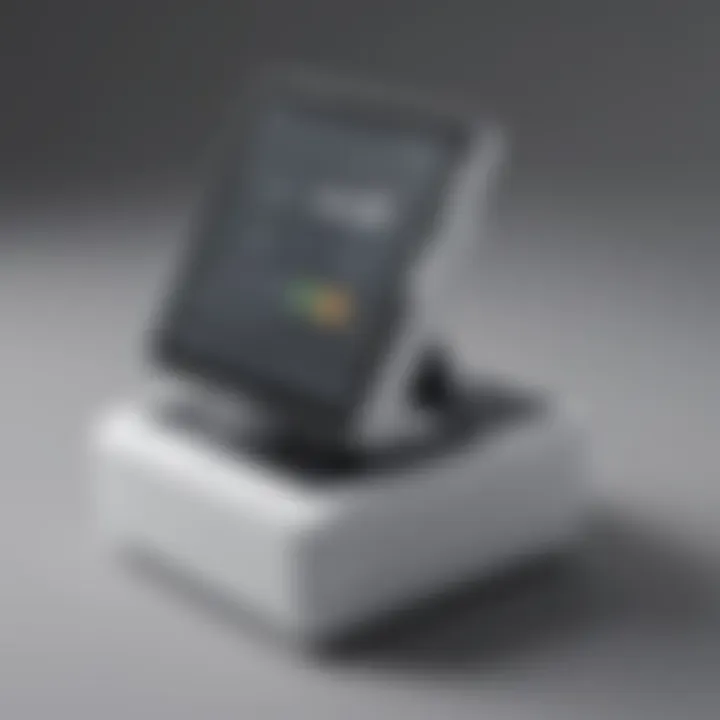Mastering the Square POS Online Store: A Full Guide


Intro
In the ever-evolving landscape of e-commerce, having the right tools can make or break a business. With the rise of online shopping, platforms like Square POS have stepped into the forefront, providing essential functionalities to facilitate seamless transactions and efficient store management. This guide aims to peel back the layers of the Square POS online store, offering a detailed look at its features, benefits, and various applications. For entrepreneurs and small to medium-sized businesses, understanding this platform is crucial in maximizing the potential of their digital storefront.
Key Features of the Software
Overview of Core Functionalities
At its core, Square POS serves as a multifaceted platform designed specifically for managing online and brick-and-mortar sales. Here are some standout functionalities:
- Payment Processing: Square offers multiple options for receiving payments, including credit cards, digital wallets, and even contactless payments. This versatility ensures customers have the freedom to choose their preferred payment method.
- Inventory Management: Keeping track of stock can be a daunting task. Square simplifies this process through an intelligent inventory management system that allows business owners to monitor stock levels, receive alerts for low inventory, and even manage suppliers.
- Analytics and Reporting: Knowledge is power. With detailed reports on sales trends and customer insights, businesses can make informed decisions based on actionable data.
These functionalities are not just bells and whistles; they represent vital tools necessary for day-to-day operations in today’s digital retail environment.
Unique Selling Points
What separates Square POS from the competition? Here are a few unique selling points:
- User-Friendly Interface: Whether you are tech-savvy or just starting, the platform is designed to minimize the learning curve, making it accessible for everyone.
- Integration Flexibility: Square allows easy integration with various third-party applications, enhancing functionality by connecting with other business systems seamlessly. This adaptability is particularly valuable for businesses looking to expand.
- Affordability: Compared to many platforms, Square offers competitive pricing, avoiding hidden fees that can eat into profits. This is especially appealing for small businesses looking to keep overhead costs low.
"Understanding your tools is half the battle in e-commerce; with Square POS, you gain not just a software but a partner in your digital journey."
In-Depth Software Analysis
Pros and Cons
To truly grasp whether Square POS is suitable for your needs, it’s vital to consider both its advantages and drawbacks:
Pros:
- Streamlined payment processing.
- Robust inventory management tools.
- Comprehensive reporting capabilities.
- No hidden charges—clear pricing structure.
Cons:
- Limited customization options for advanced users.
- Some users report occasional glitches in software performance during peak times.
Performance Metrics
Analyzing the effectiveness of Square POS doesn’t only rely on surface features. Performance metrics come into play to measure its impact:
- User Retention Rates: Many businesses report higher repeat customer rates, showcasing user satisfaction.
- Transaction Speeds: Most transactions are processed in a matter of seconds, contributing to overall efficiency and customer satisfaction.
Understanding Square POS
In today’s digital marketplace, grasping the fundamental aspects of Square POS is not merely beneficial, it can be pivotal. Square is not just a payment processor. It’s an entire ecosystem designed to facilitate seamless transactions and engagement between businesses and customers. Understanding Square POS in depth helps business owners to optimally leverage its features, driving growth and improving customer satisfaction.
Overview of Square POS
Square POS has reshaped the way transactions occur by simplifying payment processes, inventory management, and sales analysis. It provides a robust platform tailored for small to medium-sized businesses, making sophisticated tools accessible without the need for extensive technical knowledge. You could say it levels the playing field, allowing even the smallest shops to operate like industry forerunners.
Square POS combines ease of use with strength in its functionality. Its interface is intuitive, meaning even users with basic tech skills can navigate through setup and operation with relative ease. This accessibility is essential for entrepreneurs who often wear multiple hats and cannot afford to get bogged down in overly complicated systems.
Key Features
Square POS encompasses a rich array of features that facilitate not just payment processing, but holistic business management. Here’s a more detailed look at its key features that lend to its versatility:
Payment Processing
Square POS offers a comprehensive payment processing solution that accommodates various payment methods such as credit and debit cards, digital wallets like Apple Pay, and even gift cards. The real boon about Square's payment processing is (other than its simplicity) it provides real-time updates, giving businesses an instant snapshot of their sales performance.
A significant advantage of this feature is Square's transparent pricing model. Instead of hidden fees that can eat into profits, Square charges a predictable flat percentage per transaction, making budgeting simpler for businesses. However, one drawback could be the comparatively higher fees for low-volume transactions—so it's worth weighing the costs if you're running a tight operation.
Sales Analytics
Square's sales analytics tool is a goldmine for small business owners. By tracking every transaction, it provides deep insights into sales patterns, peak purchasing times, and even helps identify your best-selling products. This specific feature can help businesses make informed inventory decisions and tailor marketing efforts based on factual data rather than gut feelings.
The gain here is clear: with data in hand, a business can optimize its strategies to maximize revenue. However, it’s vital to note that while Square does provide these insights, businesses need to actively engage with the data. Ignoring it can result in missed opportunities.
Customer Management
Customer management within Square POS is another key area that can't be overlooked. The system allows businesses to store customer information, track purchase history, and even tailor marketing efforts based on individual preferences. This creates a personalized shopping experience that keeps customers coming back.
A defining trait of Square’s customer management feature is its integration capability with loyalty programs and email marketing tools, which can further enhance customer relationships. However, businesses looking to implement advanced features may find the initial setup a bit daunting due to the volume of options available. But once it’s up and running, the potential for increased customer retention is strong.
The Square POS Online Store Application
The Square POS online store application serves as a pivotal hub for businesses looking to establish a robust online presence. As shopping habits shift increasingly towards e-commerce, having a well-structured online store becomes indispensable. Square's unique application not only streamlines operations but also enhances customer engagement, securing a place for itself in the toolkit of small and medium-sized enterprises. This section will delve into the various aspects of setting up and configuring an online store within the Square POS framework, highlighting essential features and design considerations.
Setting Up the Online Store
Setting up the online store is the initial step every entrepreneur must take to tap into the e-commerce potential. This phase isn’t just about putting items on a website; it's about creating a seamless experience for both the seller and the buyer.
Account Creation
Creating an account in Square POS serves as the bedrock of your online journey. This process is straightforward and typically requires basic information like your email and business specifics. One of the standout characteristics of Square’s account creation is its integration capabilities. Once the account is set, businesses can easily link their Square systems to other platforms, allowing data to flow smoothly.
The unique feature here is how quickly you can get started. Many platforms require tedious documentation, but with Square, it's all about efficiency. This ease of setup can significantly reduce the time it takes for a business to pivot online. Just remember, simplicity comes with a trade-off; while it’s quick, ensuring robust security measures is vital to protect sensitive customer information.
Store Configuration
Configuring your store is where the magic begins. This entails tailoring your site to suit your brand’s ethos and the needs of your target audience. One of the key highlights of Square’s configuration options is the ability to customize the layout without needing extensive coding knowledge. Thus, even those who aren’t tech-savvy can accomplish a professional appearance.
A unique aspect of this configuration is the flexibility to adapt to various market demands quickly. Businesses can modify product categories, add or remove sections, and update promotional offers in just a few clicks. The advantage is undeniable—making quick adjustments based on trends can lead to improved sales outcomes. But, don't overlook the potential downside; over-customization might lead to a cluttered interface, which can overwhelm visitors.
Product Listings
Product listings are the heartbeat of any online store. This area deserves your utmost attention because it directly translates to how well customers connect with your offerings. With Square, the possibilities during product listing creation are abundant. Sellers can add multiple images, detailed descriptions, and variants of each product, creating an informative showcase.
What stands out here is the emphasis on high-quality visuals, which Square encourages. Excellent images can make a product shine, amplifying consumer interest. However, sellers must be careful with the amount of information provided—too much can deter customers. It is vital to strike a balance and ensure that product listings are engaging yet not overwhelming.
Design Considerations
Design considerations play a crucial role in influencing customer behavior. An effective store layout, consistent branding, and responsive design contribute to a positive user experience, resulting in higher conversion rates.
Layout and Navigation


The layout and navigation of your online store serve as a map for your customers. A well-organized structure helps visitors find what they need without frustration. Square offers a straightforward and adaptive layout that adjusts to various screen sizes, facilitating user-friendliness. A key characteristic is its intuitive navigation bar that helps direct shoppers to different product areas efficiently.
The unique selling point here is the ability to design with user behavior in mind. By utilizing analytics tools available in Square, businesses can understand how users interact with their site layout. One possible drawback might be the temptation to change navigation too frequently based on trends, which could confuse returning customers.
Branding Elements
Branding elements form the unique identity of your online store. When utilizing Square, businesses can incorporate logos, color schemes, and fonts that resonate with their audience. This level of customization enhances brand recall, making it easier for customers to remember and return to your store.
A notable benefit is the cohesive feel that well-chosen branding elements provide. They reinforce trust and create a professional image. However, it’s essential to maintain consistency across different platforms. Inconsistency may lead to confusion and diminish brand integrity.
Responsive Design
In today's mobile-first world, responsive design is not just an option; it's a necessity. Square excels in offering templates that automatically adjust based on the device in use. This is critical because customers now shop on various devices, from phones to tablets. A key characteristic of responsive design in Square is that it enhances user experience without additional programming efforts.
The advantage of this feature is clear; mobile users are far more likely to complete purchases if the shopping experience is tailored for them. Yet, businesses should diligently test their sites on multiple devices to ensure that responsiveness meets expectations, as glitches can detract from professional credibility.
A well-designed online store not only attract customers but retains them—a key factor for any successful e-commerce strategy.
In summary, the Square POS online store application equips businesses with the essential tools to succeed in e-commerce. From the crucial steps in setting up an online store to thoughtfully considering design elements, every factor plays its role in enhancing customer experiences. As more consumers gravitate towards digital shopping, leveraging these features becomes vital for adapting and thriving in a competitive marketplace.
Payment Processing with Square POS
Payment processing is the cornerstone of any online retail operation, and Square POS excels in this area. With a variety of payment options available, businesses can cater to the evolving preferences of their customers. The seamless integration of these payment methods can not only increase sales but also enhance customer satisfaction.
In this section, we'll dive into the payment methods supported by Square POS, the transaction fees involved, and what that means for businesses.
Payment Methods Supported
Offering multiple payment methods can be a game-changer for any business. Let’s explore the key options:
Credit and Debit Cards
Credit and debit cards remain the most widely used payment method in the online space. Their popularity stems from their convenience. Customers can make quick purchases, which is favored when they are browsing through an online store. One of the hallmark features of credit and debit cards is the security protocols like EMV and PCI compliance, which help in protecting sensitive information.
However, one must consider the dependency on these cards. Not every consumer may have a credit card, which can limit your customer base. Additionally, the transaction fees on these payments can chip away at margins over time.
Digital Wallets
Digital wallets are transforming how consumers transact in a digital landscape. With options like PayPal, Apple Pay, and Google Pay, the primary allure is simplicity. These wallets allow users to pay with just a few taps, making the checkout process smooth and efficient.
The key characteristic of digital wallets is their ability to store multiple cards in one place, which means users aren't limited to a single payment method. This can drive up conversion rates, particularly for mobile users. Nonetheless, businesses should remember that transaction fees may vary by wallet, and some may have hidden costs that can catch you off guard.
Gift Cards
Gift cards have taken on a new life in the digital marketplace. They are not just a popular gifting option but also a powerful marketing tool. Square POS makes it easy for businesses to produce and sell digital gift cards, adding a layer of versatility to payment processing.
The major advantage of gift cards is that they encourage repeat business. Once a customer buys a gift card for someone else, there’s a good chance the recipient will spend more than the card's value, effectively bringing in extra revenue. However, businesses should be wary of the need to manage inventory for physical cards or the risk of unused cards.
Transaction Fees
Transaction fees can be a thorn in the side for many businesses. Square POS' tiered pricing model simplifies this area by ensuring that business owners know exactly what they are paying from the get-go. Generally, the fees for processing payments hover around 2.6% + 10 cents per transaction for card payments. It’s simple but crucial to factor these costs into profit margins.
"Understanding transaction fees is imperative. They can impact the bottom line significantly if not accounted for."
Inventory Management Features
In the landscape of e-commerce and retail, efficient inventory management is paramount. This section illuminates how Square POS equips businesses with the necessary tools to maintain optimal stock levels and effectively track inventory performance. A well-organized inventory system not only minimizes losses but also enhances customer satisfaction, ultimately driving sales and fostering loyalty.
Product Management
Stock Levels
When it comes to stock levels, a keen understanding of how much product is on hand is crucial for any business. Underestimating or overestimating stock can lead to significant financial repercussions. Square POS allows for real-time tracking of stock levels, ensuring that businesses can respond proactively to demand fluctuations and prevent stockouts. This feature is particularly beneficial for small to medium-sized businesses that rely on accurate reporting to make informed purchasing decisions.
Key characteristics of stock levels include the ability to set reorder points. When inventory dips to a predetermined threshold, Square POS can trigger alerts, enabling business owners to restock before inventory runs out. This not only keeps customers happy but also ensures that sales are not lost due to unavailable products.
"Managing stock levels efficiently is not optional; it's a necessity for thriving in a competitive market."
However, there are challenges. Maintaining an optimal stock level may require foresight and accurate forecasting data, which can sometimes be elusive for newer businesses. Nevertheless, the advantages of real-time tracking through Square POS far outweigh the pitfalls.
Variants and Options
Variants and options represent another cornerstone of effective product management. This feature allows businesses to offer different sizes, colors, or configurations of a product without duplicating listings. For example, a clothing store can seamlessly offer a shirt in multiple colors by using variants instead of creating a separate listing for each one.
The key characteristic here is flexibility. Business owners can tailor their inventory to meet diverse customer preferences, which can lead to increased sales and reduced excess inventory. Moreover, this streamlined approach helps to maintain a cohesive shopping experience for customers, as they can easily find all the variations of a single product.
While this feature is popular due to its efficiency and ease of use, it does come with its own challenges. For instance, managing numerous variants can become overwhelming if not properly organized. However, the ability to see aggregated data on sales performance across variants can drive marketing strategies and inventory decisions.
Reporting Tools
Sales Reports
Sales reports are indispensable for any business wanting to gauge performance. Square POS offers detailed sales reports that provide insights into which products are flying off the shelves and which ones are lagging. By analyzing these reports, business owners can make informed decisions on whether to discontinue a product, adjust pricing, or increase marketing efforts.
The hallmark of good sales reporting is its ability to highlight trends over time. Being able to see seasonal patterns can help businesses tailor their inventory according to demand, preparing ahead of time for peak seasons, such as holidays. This feature is especially crucial for small entrepreneurs looking to maximize their profitability.
But, as with any tool, there are considerations. If businesses rely solely on historical data without considering current market trends, they may miss opportunities for growth. Therefore, it’s essential to combine these insights with ongoing market research.
Inventory Tracking
Inventory tracking represents a crucial part of the inventory management puzzle. It entails keeping a finger on the pulse of your stock — knowing not only how much is sold, but also the condition of remaining inventory. Square POS facilitates this by enabling real-time updates on stock status, allowing businesses to respond promptly.
The defining characteristic of effective inventory tracking is its capability for granular oversight. From viewing which items are available in the warehouse to tracking items in transit, this feature proves to be invaluable for businesses that operate both online and in physical locations.
A potential drawback could be that implementing thorough inventory tracking requires a comprehensive process. Businesses may need to invest in training staff or refining existing operations to ensure accuracy. Yet, in the long run, this investment yields significant returns through better stock management and reduced waste.
Customer Experience
In the competitive arena of online retail, creating a positive customer experience is not just advantageous; it's essential. No one wants to feel like just another number when navigating through a store. A remarkable customer experience fosters loyalty, encourages repeat purchases, and cultivates positive word-of-mouth referrals—all key ingredients for any business's success. When users browse the Square POS online store, they should encounter a seamless interface and readily available support, enhancing their overall shopping journey.
User Interface Considerations
Ease of Use
The ease of use factor can make or break an online shopping experience. Customers should be able to navigate the store without scratching their heads. A clean layout and intuitive navigation contribute significantly to this aspect. It’s all about simplicity. The main characteristic of ease of use here is to minimize barriers so users can reach their destination with as few clicks as possible.


A unique feature associated with ease of use is the search functionality. A prominent search bar allows customers to find specific products quickly. This not only reduces frustration but also speeds up the shopping process, making it a popular choice in this article. However, if this feature isn't optimized for accuracy, it could lead to customer dissatisfaction. A robust ease of use strategy that balances simplicity and efficiency is vital.
Accessibility Features
When it comes to accessibility features, having options that cater to all kinds of customers is paramount. The target is to ensure that everyone, regardless of their abilities, can enjoy a seamless experience. Key characteristic here is inclusivity. Visibility and legibility of information are paramount, which means that fonts should be bold, and contrasts clear.
A unique element of accessibility features is keyboard navigation. Many users prefer this method over using a mouse. It can make a significant difference for those with mobility impairments. While accessibility might require additional design considerations, the upside is the potential for a wider customer base. Integrating accessibility doesn't just fulfill a legal requirement; it enhances customer satisfaction.
Customer Support Options
Live Chat
The live chat feature is a game changer in customer support. The immediacy it offers can be the difference between closing a sale or losing a customer. Being able to communicate in real time allows businesses to resolve issues quickly, which can instill confidence in customers.
Key characteristic of live chat is its accessibility. It’s right there on the site, often as a small icon, ready for users to click at a moment's notice. A unique feature of live chat is the use of bots for initial support, which can handle common inquiries quickly and free up human agents for more complex issues. However, over-reliance on bots might leave some customers wanting human interaction. Balancing automation with personalized service is essential to maximizing benefits.
Email Support
Email support, while not as instant as live chat, provides a different but equally crucial avenue for customer interaction. This method is particularly useful for issues that are more complex and require detailed explanations. The key characteristic here is asynchronous communication, allowing users to reach out whenever they like without needing immediate responses.
A unique aspect of email support is the ability to attach documents or images. This capability can clarify issues significantly. The downside, however, is the potential for delayed responses, which can frustrate customers expecting quicker resolutions. It's essential to be transparent about response times to manage expectations.
Knowledge Base
A well-structured knowledge base transforms how customers find answers. This treasure trove of information serves as a self-service tool, offering immediate solutions to common questions. The key here is accessibility—information should be easy to find, organized intuitively, and regularly updated.
What makes a knowledge base particularly useful is its searchability. Customers can quickly type in keywords and access relevant articles or solutions. This not only alleviates the pressure on support teams but also empowers customers. However, if the content isn’t kept fresh or user-friendly, it can be more of a hindrance than a help. Maintaining your knowledge base can ensure that it remains a valuable resource for both the business and its customers.
Integrations with Other Software
In the digital age, the ability to integrate various software solutions seamlessly can make or break a business’s efficiency and operational capabilities. For businesses using Square POS, integrating with other software is not just a matter of convenience; it’s a crucial step toward maximizing productivity and ensuring comprehensive data flow.
These integrations allow for heightened functionality across different platforms, supporting everything from e-commerce to accounting. When businesses can connect their Square POS with other tools, they unlock a chain of benefits that can lead to more effective decision-making, enhanced customer experiences, and optimized operations. Here’s an in-depth look into some of the most popular integrations that can bolster a business’s online store.
E-commerce Platforms
Shopify
Shopify stands out as a powerful e-commerce platform that simplifies creating and managing online stores. One of its most significant contributions is enabling users to set up their e-commerce businesses quickly, even if they lack technical skills. This simplicity is among the key characteristics of Shopify—it offers various templates that are easy to customize.
A unique feature of Shopify is its ability to support multichannel selling, meaning businesses can sell through various channels like social media and in-person while simultaneously managing everything from the Shopify dashboard. This multi-channel capability can be a game changer for entrepreneurs looking to expand their market reach.
However, while Shopify presents substantial advantages, it does come with some downsides, such as transaction fees if you opt for payment processors other than Shopify Payments. Despite these cons, many businesses find the ease of use and robust features that Shopify provides make it a preferable choice.
WooCommerce
WooCommerce is another popular e-commerce choice for Square POS users, particularly for those already familiar with WordPress. This plugin turns a WordPress site into a fully functioning online store. Its primary advantage lies in its flexibility, allowing users to customize their stores with a high degree of control over every aspect.
The standout characteristic of WooCommerce is its open-source nature, meaning businesses can modify and expand their store’s functionality without facing stringent limitations—quite appealing for those with specific needs.
However, one of the unique challenges with WooCommerce is the potential need for ongoing development and maintenance, which might require a certain level of technical expertise. Therefore, businesses may need to weigh their resource availability against the platform's benefits.
Accounting and Invoicing Software
QuickBooks
QuickBooks is a renowned accounting software favored by small to medium-sized businesses. Its integration with Square POS is vital as it simplifies financial tracking and reporting. QuickBooks automates invoicing, expense tracking, and financial statements, making it a valuable asset for any business owner.
A notable characteristic of QuickBooks is its simple interface, which allows users to access essential financial data easily. This user-friendliness can be a significant plus for business owners who may not have extensive accounting training.
However, the downside is that QuickBooks may sometimes require a steep learning curve, especially for businesses that aim to utilize its advanced features. Nonetheless, the comprehensive insights gained truly make it worthwhile.
Xero
Xero is another leading accounting tool that integrates effectively with Square POS, especially appreciated by those looking for a cloud-based solution. Its primary contribution is its ability to provide real-time financial data, which can help business owners make informed decisions.
A key feature of Xero is its mobile app, which allows users to manage finances on the go—ideal for entrepreneurs always on the move. This functionality can significantly contribute to effective cash flow management.
However, like any tool available, Xero has its complexities, which might overwhelm new users. It's essential to consider these attributes to understand whether its features align with business needs.
In summary, by integrating Square POS with tools like Shopify, WooCommerce, QuickBooks, and Xero, businesses can branch out their operational capabilities, streamline processes, and enhance overall effectiveness. Understanding the unique characteristics and advantages of these integrations can guide entrepreneurs in making informed decisions that benefit their operations.
Marketing Tools Available
Navigating the online retail space requires more than just a functional store—it’s about how you connect with customers and how encouraging they feel to make a purchase. Marketing tools particularly play a crucial role in achieving these goals. They allow businesses to promote their offerings, engage with their audience, and drive sales effectively. Square POS offers various marketing tools designed to cater to various marketing strategies, emphasizing flexibility and accessibility for small to medium-sized businesses.
Email Marketing Integration
Campaign Management
Campaign management is a backbone of effective email marketing strategies. It involves creating, managing, and analyzing promotional campaigns sent via email. This aspect of marketing helps businesses tailor their messaging according to customer preferences and behaviors. A standout characteristic of campaign management is automation, which enables businesses to send personalized messages based on customer interactions and purchase history.
For the Square POS user, this tool is a beneficial choice due to its user-friendly interface and seamless integration into the existing system. One unique feature of Square's campaign management is the ability to segment audiences based on their buying behaviors. This means businesses can deliver targeted emails that resonate more deeply with specific customer groups. On the downside, while automation reduces manual work, it may lead to generic messaging if not closely monitored.
Subscriber Management
Subscriber management focuses on handling and organizing your email list, ensuring that your communications reach the right audience. A key characteristic of this tool is opt-in forms that collect customer data, which can help build a healthy mailing list over time. It's a popular option here because it not only helps in growing the list but ensures compliance with data protection laws, which is increasingly important in today's digital landscape.
One unique feature in Square's subscriber management is the integration with other customer management tools. This allows businesses to easily track subscriber behavior and engagement, improving the way they approach future communications. However, as the list grows, maintaining engagement can become challenging, requiring businesses to regularly clean up their lists to remove inactive subscribers.
Promotional Tools
Coupons and Discounts
Coupons and discounts are time-tested tools for enticing customers and driving sales. They create a sense of urgency and can significantly influence purchasing decisions. A defining feature of these tools in the Square system is their simplicity of use, allowing businesses to generate discount codes in mere minutes. This efficiency is a definite plus, especially for time-pressed entrepreneurs.
Moreover, implementing these promotions can attract new customers and reactivate previous ones, enabling retailers to retain a competitive edge. Unique to Square is the ability to tailor promotions to customer groups or individuals, based on previous shopping habits. The downside, however, may come in the form of over-reliance on discounts, potentially undermining perceived value in the long run.
Loyalty Programs
Loyalty programs foster customer retention by incentivizing repeat business. They engage customers beyond a one-time purchase, encouraging ongoing interaction with the brand. A key element of loyalty programs is point systems, rewarding customers for every purchase they make. This can create a robust returning customer base, a significant advantage in today's competitive market.
Unique to Square's offering is the ability to track loyalty points across multiple channels, enhancing the overall customer experience. Customers can accumulate and redeem points through both online and in-person transactions seamlessly. Nevertheless, setting up an effective loyalty program requires careful planning to prevent over-complication, which may alienate customers who prefer straightforward shopping experiences.
Effective use of marketing tools ultimately translates to a greater understanding of customer needs and preferences, paving the road to sustainable growth for businesses.


Best Practices for Using Square POS Online Store
Successfully using the Square POS online store is not just about setting it up and listing products. It's a bit like planting a garden: you need to nurture it for it to bloom. Best practices allow business owners to maximize the platform’s potential, enhance customer experience, and drive sales. Engaging with the right strategies can make all the difference between a thriving online store and one that just sits there gathering digital dust.
Optimizing Product Listings
High-Quality Images
In the realm of e-commerce, first impressions count for everything. When a potential customer lands on a product page, that first look can make or break the sale. High-quality images are what will draw them in, much like a moth to a flame. Observing the brilliance of a product through sharp, professional photographs gives buyers the confidence that what they see is what they’ll get.
These images should not only be high resolution but should also showcase different angles and contexts. For instance, if you’re selling a piece of furniture, a picture showing it in a well-decorated room gives a better sense of how it can fit into a customer’s home.
Advantages of High-Quality Images:
- Improved Conversion Rates: Studies have shown that products with high-quality visuals tend to sell much better than those with poor-quality images.
- Reduced Returns: When customers get a real sense of the product, they’re less likely to be surprised (and disappointed) when it arrives in the mail.
In summary, investing in great photography pays off well; it’s not just flashy but rooted in very real consumer behavior.
Detailed Descriptions
A solid product description is like the friendly sales assistant in a brick-and-mortar store. It informs, engages, and persuasive. Detailed descriptions should explain what the product is, its features, and how it benefits the consumer. Forgetting the unique selling propositions can lead to potential customers scrolling right on by.
Effective descriptions don’t just list features—like size and color—but connect emotionally with buyers. For example, if you’re selling a pair of shoes, explain that the cushioning technology not only provides comfort for long walks but also supports the arch, making them perfect for anyone on-the-go.
Advantages of Detailed Descriptions:
- Increased Engagement: The longer customers linger on a product page, the more likely they are to make a purchase.
- SEO Benefits: Crafting unique, informative descriptions can also help your products rank better on search engines, bringing more organic traffic.
In sum, detailed descriptions build a story around your product, creating a connection that often leads to sales.
Enhancing User Experience
Fast Loading Times
In today's fast-paced digital world, patience is thin. If a website takes too long to load, customers are likely to abandon their carts faster than a kid with a melted ice cream on a hot day. Optimizing for speed is non-negotiable. A fast-loading website enhances the user experience significantly and can lead to better sales.
Tools such as Google's PageSpeed Insights can help in identifying potential bottlenecks. Whether it's unoptimized images or too many plugins, knowing what’s causing the slowdown means you can address it directly.
Advantages of Fast Loading Times:
- Better SEO Rankings: Search engines like Google penalize slow sites, affecting overall visibility.
- Reduced Bounce Rates: Fast responses tend to keep customers engaged, and engaged customers are more likely to convert.
Clear Call to Action
A clear call to action, or CTA, directs visitors toward what you want them to do next, be it ‘Buy Now’, ‘Sign Up’, or ‘Learn More’. It’s the breadcrumb trail leading to conversion. A compelling CTA gives a sense of urgency or exclusivity. For example, ‘Limited Stock – Buy Yours Today!’ encourages immediate action.
Contrast is key: a great CTA stands out on the page and is easy to find. It should be visually distinct–think bold colors or larger font sizes, but still within the overall branding.
Advantages of a Clear Call to Action:
- Increased Conversion Rates: Customers who know what steps to take next are likely to complete their purchases without getting confused.
- Improved User Journey: Clear directions create a smoother shopping experience, increasing satisfaction.
Rounding all of this off, implementing best practices in product listings and user experience is a game changer. When utilized effectively, Square POS online store can blossom into a thriving e-commerce haven.
Remember: It’s not just about making a sale today, but building a loyal customer base for the future.
Case Studies and Real-World Applications
Examining case studies and real-world applications is crucial in understanding the effectiveness of the Square POS online store for businesses. These real-life examples serve as a window into how various small to medium-sized enterprises harness the features of Square POS to streamline operations, boost sales, and improve customer satisfaction.
The importance of this section can be boiled down to several key benefits:
- Practical Insights: Case studies offer concrete examples of how companies implemented Square POS, showcasing practical applications of its capabilities.
- Inspiration: Learning about the successes of other businesses can inspire entrepreneurs to experiment with similar strategies or adapt them to their unique situations.
- Learning from Pitfalls: By analyzing failures or challenges faced by others, it helps in avoiding those same mistakes and aids in planning more effectively.
- Evidence-based Outcomes: These examples present data-driven results, highlighting the tangible benefits associated with Square POS use, which can help in justifying investments in such systems.
Through these narratives, we delve into how the technology, when effectively implemented, can elevate an online store’s performance.
Success Stories from Small Businesses
Small businesses often face unique challenges, and success stories showcase how they navigate these hurdles with the aid of Square POS. For instance, consider a local bakery that struggled with inventory tracking due to fluctuations in demand. They decided to switch to Square POS for their online store.
After careful implementation, they reported:
- Enhanced Inventory Management: With real-time tracking, the bakery could manage stock levels efficiently, ensuring they never run out of popular items.
- Increased Sales: By offering online ordering, they expanded their customer base significantly, reaching clients who preferred the convenience of ordering from home.
- Streamlined Operations: The integration of communication tools allowed for smoother operations, connecting front-end orders with back-end inventory seamlessly.
Such success stories not only highlight the operational benefits but also emphasize the impact on customer satisfaction, leading to increased loyalty and repeat business.
Lessons Learned from Implementations
Analyzing lessons learned from various implementations presents a roadmap for future users of Square POS. Many businesses began their journey with high hopes, but some faced stumbling blocks that provided valuable takeaways.
- Customization Matters: Several businesses found that customizing their Square POS setup took time but brought about significant improvements in usability. This led to the conclusion that investing time in proper configuration upfront pays off immensely.
- Training Staff is Key: Businesses reported that providing adequate training not only eased the transition to the system but also maximized its features. Training staff to fully utilize Square POS led to more efficient service and reduced errors in transactions.
- Continuous Adaptation: The online retail landscape is ever-changing. Businesses experienced greater success when they remained agile, frequently updating their strategies based on customer feedback and sales data.
By distilling these lessons into actionable insights, future users can set realistic expectations and devise strategies for successful implementation. Understanding where others stumbled allows prospective users to stride confidently into the Square POS ecosystem, armed with knowledge that can lead to triumph rather than trial.
Future Trends in Online Retail with Square
As online retail continues to evolve, Square POS is at the forefront of these shifts. Understanding the future trends is crucial for small to medium-sized businesses, as it can help them adapt and thrive in an ever-changing digital landscape. This section looks at key developments such as emerging technologies and evolving consumer expectations. Each trend brings both opportunities and challenges, highlighting why staying informed is essential for any business looking to leverage Square POS effectively.
Emerging Technologies
Artificial Intelligence
Artificial Intelligence (AI) is making waves in just about every industry, and online retail is no exception. One major aspect of AI is its ability to personalize the shopping experience. By analyzing consumer data, AI can recommend products tailored to the preferences of individual customers. This is more than just a nifty feature; it can significantly boost conversion rates.
A standout characteristic of AI is its capacity to process vast amounts of data quickly. This is a beneficial trait for online retailers looking to enhance customer engagement. AI-driven chatbots, for instance, can provide 24/7 customer support, addressing queries in real time, which improves customer satisfaction greatly.
However, these technologies aren't without drawbacks. Implementing AI can be a costly endeavor and may require upfront investment in infrastructure. Businesses must weigh the benefits against the costs. In essence, while AI offers unique features like personalized shopping experiences, the trade-offs should be considered carefully.
"AI isn't just a feature; it's a game-changer for companies aiming for higher sales and better customer relations."
Augmented Reality
Augmented Reality (AR) is another progressive technology that’s reshaping how businesses engage with customers. AR allows potential buyers to visualize products in their own space before making a purchase. This is especially beneficial in retail sectors like furniture or fashion, where trying before buying can sway consumer decisions.
A key characteristic of AR is that it enriches the shopping experience by merging the physical and digital worlds. Customers can use their smartphones to view how a piece of furniture would look in their home, providing a compelling reason to buy. This immersive experience can greatly reduce return rates, as consumers are likely to be more satisfied with their purchases.
However, as with any new technology, there are limitations. AR requires robust internet connections and can be resource-intensive. Not all businesses might find such technology within reach, or may need to invest significantly to offer it. Likewise, while AR enhances consumer interaction, the implementation can be complex, requiring technical know-how.
Evolving Consumer Expectations
The expectations of today’s consumers are continually evolving, with demand for seamless and personalized shopping experiences becoming the norm. More than ever, consumers are looking for convenience and efficiency in their online shopping. They assume that brands know their preferences and can adapt to their needs accordingly.
In light of this shift, businesses using Square POS have to be proactive in how they respond to changing consumer behaviors. From optimizing mobile access to ensuring user-friendly interfaces, it’s vital to focus on enhancing the overall shopping journey. Expectations now also encompass sustainability; many customers prefer brands that commit to environmentally friendly practices.















